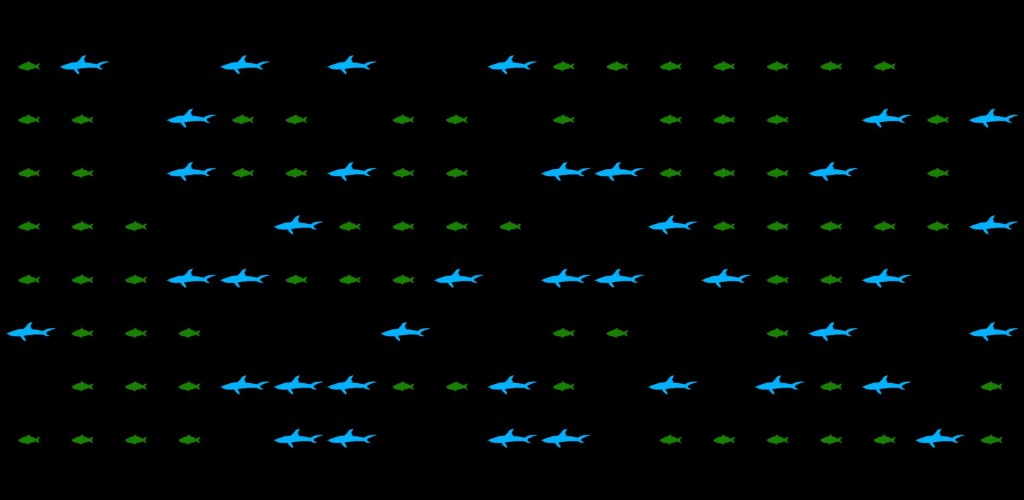What is Green Wa-tor?
Wa-tor is a computer-based simulation of the competition for survival between
sharks and fish. The three-dimensional image of the ocean is spread over
the surface of a perforated donut-shaped planet. On a computer, it is represented
as a sea where the top and bottom edges of the screen and the right and
left edges are connected. For details, see Wikipedia.
Green Wa-tor simulates the Wa-tor sea when it is contaminated with plastic.
Download "Green Wa-tor" on Google Play

Wa-tor simulation
There are sharks and fish in the Wa-tor sea. Sharks and fish make their
own movements every unit time.
Fish movement: The sea is rich in invisible plankton, so fish swim freely
and breed at regular intervals.
Shark movements: Sharks swim freely in the ocean and prey on fish around
them. If they cannot prey on fish for a certain period of time, they will
starve to death. If they do not starve, they will breed at regular intervals.
Green Wa-tor simulation
In addition to Wa-tor behavior, Green Wa-tor has the following behaviors:
Every unit time, the sea is contaminated with plastic at a constant rate.
Fish swim freely in the ocean, but they mistake plastic for food and eat
it. Fish will die if they eat more plastic than they can withstand.
Sharks are smart and don't eat plastic. However, since it is not possible
to distinguish between fish that ate plastic and fish that did not, they
prey on both. The plastic that the fish ate also accumulates in the shark,
and if the plastic capacity of the shark is exceeded, the shark will die.
After the fish and sharks die, if they were eating plastic, you can set
the simulation conditions to remain as plastic or corpses.
What is the end of Green Wa-tor?
Enjoy changing the simulation settings.
Graphics description
Light blue: shark
Purple: Sharks having ingested plastic
Green: fish
Yellow: Fish having ingested plastic
White: plastic
Red: Carcasses of sharks having ingested plastic
Orange: Carcasses of fish having ingested plastic
Summary of setting values
Settings
Number of fish: Maximum initial value of fish
Breeding of fish: Fish breed every time this unit time elapses. Maximum
value.
Number of shark: Maximum initial shark value
Breeding of shark: Sharks breed every time this unit time elapses. Maximum
value.
Starve of shark: Sharks starve if they cannot prey on fish within this
unit time
Plastic rate: Number of plastics increasing per unit time (maximum value)
Fish durability against plastic: The number of plastics that fish die when
eaten
Shark durability against plastic: The number of plastics that sharks die
when ingested
Display settings
Square: The simulation graphics are represented by a rectangle. Simulation
speed is fast.
Image: An image of the graphics of the simulation. Simulation speed is
slow.
Graphics size: Vertical and horizontal sizes of sharks and fish. The larger
the image, the rougher the image.
Interval time(ms): The unit time of the simulation. Even if it is set small,
it will be slow if the calculation cannot catch up.
Rule setting
Settings when sharks or fish die after eating plastics
they go back to plastics: Return to Plastic. Plastic has a concentration
but is indistinguishable.
they become corpsed: Sharks and fish remain as carcasses
